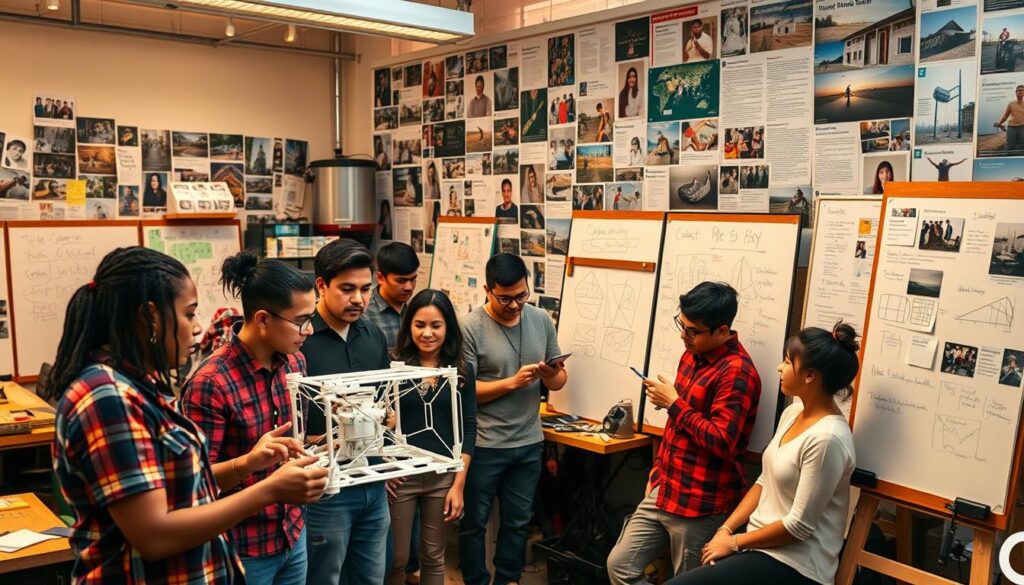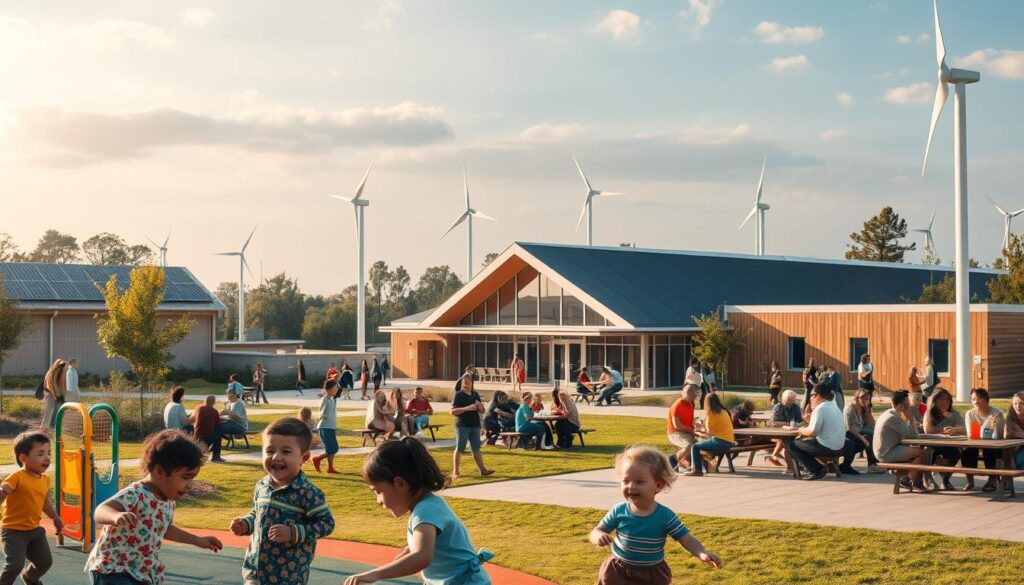The International Community Program has successfully implemented hundreds of infrastructure projects worldwide, with a focus on community-based, community-owned, and community-maintained initiatives. This approach has transformed numerous communities, fostering sustainable development and improving the quality of life for residents.
Engineers are playing a vital role in this process, utilizing their skills to drive positive change. Organizations like Engineers Without Borders are at the forefront, working on projects that range from providing clean water to constructing sustainable buildings. For instance, the use of green roofs, energy-efficient lighting, and materials that lower carbon footprints are part of sustainable development practices that are being adopted globally.
Key Takeaways
- Community-based infrastructure projects are crucial for sustainable development.
- Engineers are driving positive change through their work.
- Sustainable practices, such as green roofs and energy-efficient lighting, are being adopted worldwide.
- Organizations like Engineers Without Borders are leading community development initiatives.
- Community ownership and maintenance are key to the success of infrastructure projects.
Understanding Engineering for Social Impact
As the world grapples with numerous social and environmental challenges, the role of engineering in driving positive change has become increasingly important. Engineering for social impact is an emerging field that focuses on developing innovative engineering solutions to address complex societal issues.
Definition and Scope
Engineering for social impact encompasses a broad range of disciplines, including biomedical engineering, which applies engineering principles to healthcare challenges. This field involves the development of medical devices, prosthetics, and diagnostic equipment that improve healthcare outcomes in communities worldwide. The scope of engineering for social impact is vast, covering areas such as sustainable infrastructure, renewable energy, and accessible technologies.
By leveraging technology for social good, engineers can create solutions that are not only innovative but also equitable and sustainable. For instance, advancements in biomedical engineering have led to the development of affordable prosthetics and diagnostic tools, significantly improving healthcare access in underserved regions.
Importance in Today’s World
In today’s world, where social and environmental challenges are increasingly complex, the importance of social impact initiatives cannot be overstated. Engineering solutions play a critical role in addressing issues such as climate change, healthcare disparities, and infrastructure deficiencies. According to a recent article on engineering ethics, the integration of ethical considerations into engineering practices is crucial for ensuring that solutions are not only effective but also responsible and equitable.
The significance of engineering for social impact lies in its potential to drive meaningful change. By developing and implementing engineering solutions that are tailored to the needs of diverse communities, engineers can contribute to creating a more just and sustainable world.
Historical Perspective of Social Impact Engineering

Social impact engineering has a long history of transforming communities through groundbreaking projects. This field has evolved significantly over the years, driven by the need to address societal challenges and improve the quality of life for people around the world.
The evolution of social impact engineering is marked by numerous milestones that have shaped its definition and scope. One of the earliest examples is the construction of ancient infrastructure, such as aqueducts and public buildings, which served the needs of local populations.
Milestones in Engineering for Social Good
Several key milestones have defined the trajectory of social impact engineering. The development of sanitation systems in the 19th century, for instance, significantly improved public health in urban areas. More recently, initiatives like the Community Engineering Corps in the United States have brought together volunteer engineers and underserved communities to advance local infrastructure solutions.
Notable Projects that Made a Difference
Notable projects have demonstrated the power of social impact engineering. For example, the development of affordable housing solutions in low-income communities has not only provided shelter but also fostered community development. Similarly, projects focused on improving access to clean water and sanitation have had a profound impact on public health.
These projects highlight the importance of engineering for community well-being and demonstrate how social engineering projects can drive positive change. By understanding the historical context and evolution of social impact engineering, we can better appreciate its role in shaping a more equitable and sustainable future.
Key Principles of Socially Responsible Engineering
At the heart of socially responsible engineering is a multifaceted approach that integrates sustainability, inclusivity, and accessibility. This approach is not just about adopting new technologies or methodologies; it’s about fundamentally rethinking how engineering can serve the needs of both people and the planet.
Sustainability Focus
Sustainable engineering practices are crucial for reducing the environmental footprint of engineering projects. This involves designing systems and infrastructure that are not only efficient but also environmentally friendly. For instance, the use of renewable energy sources, such as solar and wind power, is becoming increasingly prevalent in engineering projects. As noted in a report by the SGR article, “the integration of sustainability into engineering practices is not just a moral imperative but also a technical and economic one.”
The focus on sustainability also extends to the materials used in engineering projects. Engineers are now more inclined to use recycled materials, sustainable timber, and other eco-friendly materials to minimize environmental impact. This shift is driven by the recognition that sustainable engineering practices are essential for the long-term health of our planet.
Inclusivity and Accessibility
Inclusivity and accessibility are equally important principles of socially responsible engineering. This involves designing solutions that are accessible to everyone, regardless of their physical ability or socioeconomic status. Engineers are now using integrative design processes that bring together architects, engineers, and the community to ensure that every voice is heard. As the data suggests, “integrative design gathers architects and engineers, and the community at the drawing board, ensuring every voice is heard.”
For example, in the development of new urban infrastructure, engineers are incorporating designs that are accessible to people with disabilities, ensuring that public spaces are usable by everyone. This not only enhances the quality of life for individuals with disabilities but also contributes to a more inclusive society.
“The true sign of intelligence is not knowledge but imagination.” – Albert Einstein
In conclusion, the key principles of socially responsible engineering—sustainability, inclusivity, and accessibility—are transforming the field of engineering. By embracing these principles, engineers can create solutions that not only drive technological innovation but also promote social equity and environmental stewardship.
Case Studies of Successful Social Impact Projects

Engineers Without Borders has been at the forefront of implementing impactful projects globally, showcasing the power of engineering solutions for social impact. Their work spans various regions, addressing critical needs through innovative approaches.
Water Supply Solutions in Developing Regions
In many developing regions, access to clean water is a significant challenge. Organizations like Engineers Without Borders have implemented water supply solutions that have transformed communities. These projects not only provide clean water but also educate locals on water management and hygiene practices.
For instance, in a project in Africa, Engineers Without Borders designed and implemented a rainwater harvesting system that supplied clean water to a community of over 1,000 people. This project was a significant social impact initiative that improved health outcomes and reduced the time spent by community members fetching water from distant sources.
Renewable Energy Initiatives
Renewable energy is another area where engineering solutions have made a substantial impact. By harnessing solar, wind, and hydro energy, communities in developing regions have gained access to reliable and sustainable energy sources.
A notable example is a solar-powered electricity project implemented by Engineers Without Borders in a rural village. This community development through engineering project not only provided electricity to homes and businesses but also enabled the community to establish new economic opportunities, thereby enhancing their overall quality of life.
These case studies demonstrate the potential of social impact initiatives to drive meaningful change in communities worldwide. By focusing on sustainable and innovative engineering solutions, we can continue to address some of the world’s most pressing challenges.
Challenges in Implementing Social Impact Engineering
Despite its potential, social impact engineering faces numerous obstacles that hinder its successful implementation. Biomedical engineers, for instance, often struggle to make their technologies accessible and affordable for all.
Funding and Resource Allocation
One of the primary challenges is securing sufficient funding and allocating resources effectively. Social impact engineering projects often require significant investment in infrastructure, technology, and human resources.
To overcome these challenges, engineers can explore alternative funding sources, such as grants, crowdfunding, or partnerships with nonprofit organizations.
Balancing Innovation with Community Needs
Another critical challenge is balancing innovation with the actual needs of the community. Engineers must ensure that their solutions are not only cutting-edge but also relevant and beneficial to the target population.
This requires a deep understanding of the community’s needs, preferences, and cultural context. By engaging closely with local stakeholders and incorporating their feedback, engineers can develop solutions that are both innovative and effective.
Ultimately, addressing these challenges is crucial to the success of social impact engineering projects. By securing adequate funding, allocating resources efficiently, and balancing innovation with community needs, engineers can create meaningful and lasting impact.
The Role of Engineers in Promoting Social Change
![]()
Socially responsible engineers facilitate change by bridging the gap between technical possibilities and community aspirations. This role is crucial in today’s world, where technology and innovation can be harnessed for the greater good.
Advocacy and Leadership
Engineers can drive social change through advocacy and leadership. By taking on leadership roles, they can influence project directions and ensure that community needs are met. Advocacy involves promoting the use of technology for social good, raising awareness about important issues, and supporting policies that benefit the community.
- Promoting sustainable practices through renewable energy initiatives
- Advocating for inclusive design that benefits all members of the community
- Leading projects that address specific social challenges, such as access to clean water or healthcare
Grassroots Movements
Grassroots movements are another avenue through which engineers can promote social change. These movements involve working closely with local communities to understand their needs and develop solutions that are tailored to their specific contexts.
Engineers involved in grassroots movements can:
- Collaborate with community members to identify key challenges
- Develop and implement social impact initiatives that are locally relevant
- Support the development of local capacity and infrastructure
By engaging in advocacy, leadership, and grassroots movements, engineers can play a pivotal role in promoting social change and enhancing community well-being through technology and innovation.
Educational Pathways for Aspiring Engineers
Aspiring engineers can now pursue a variety of educational pathways tailored to social impact engineering. These programs are designed to equip students with the knowledge and skills necessary to develop engineering solutions that address community needs and promote sustainable practices.
Several institutions have introduced specialized courses that focus on the social implications of engineering. For instance, The Johns Hopkins Department of Biomedical Engineering offers a course on Social Justice for Engineers, highlighting the importance of community development through engineering.
Relevant Degree Programs
Universities worldwide are now offering degree programs that cater to the growing demand for engineers who can develop sustainable engineering practices. Some of these programs include:
- Environmental Engineering
- Sustainable Design Engineering
- Community Development Engineering
These programs often incorporate coursework on ethics, community engagement, and sustainable development, providing a comprehensive education that prepares students for the challenges of social impact engineering.
Certifications in Social Impact Engineering
In addition to degree programs, various certifications can further enhance an engineer’s ability to contribute to social impact projects. For example, engineers can pursue certifications in sustainable engineering or community development. More information on such opportunities can be found on platforms like Engineering for Change, which offers fellowships and training programs for engineers.
Engineers can also explore career opportunities that align with their skills and interests through resources like World Civil Society, which provides insights into engineering careers that focus on social impact.
| Certification | Description | Institution |
|---|---|---|
| Sustainable Engineering Certification | Focuses on sustainable practices in engineering | Environmental Engineering Institute |
| Community Development Certification | Emphasizes community engagement and development | Global Engineering Academy |
| Social Impact Engineering Certification | Covers the principles of social impact engineering | Social Impact Engineering Council |
By pursuing these educational pathways, aspiring engineers can gain the necessary skills and knowledge to make a meaningful difference in their communities through engineering solutions that promote sustainable engineering practices.
Collaboration Across Disciplines

The power of interdisciplinary collaboration is evident in the realm of engineering for social impact. By bringing together diverse expertise and perspectives, social engineering projects can be more effectively designed and implemented to meet the complex needs of communities.
Partnerships with Nonprofits
Nonprofit organizations play a vital role in social engineering projects by providing insights into community needs and facilitating access to local resources. For instance, Engineers Without Borders partners with local communities and organizations to implement sustainable engineering projects. Such collaborations not only enhance the technical quality of projects but also ensure their long-term sustainability.
These partnerships allow for a more nuanced understanding of the social and environmental contexts in which projects are implemented. By working together, engineers and nonprofits can develop innovative solutions that are tailored to the specific needs of the communities they serve.
Working with Government Agencies
Government agencies are crucial partners in technology for social good initiatives, as they can provide regulatory support, funding, and scalability to engineering projects. Collaborations with government agencies enable social impact engineering projects to reach a wider audience and have a more significant impact.
Effective partnerships with government agencies require a deep understanding of policy frameworks and regulatory environments. By working closely with these agencies, engineers can ensure that their projects are compliant with existing regulations and are positioned for long-term success.
Through these collaborations, engineering for social impact can achieve greater scale and sustainability, ultimately contributing to the betterment of society.
Technological Innovations Driving Social Impact
Technological innovations are revolutionizing the way we approach social challenges. By harnessing the power of engineering solutions, we can drive significant social impact initiatives that transform communities. This section will explore the role of technology in creating positive change, focusing on smart cities and health technologies.
Smart Cities and Urban Development
Smart cities represent a significant area where technological innovation is driving social impact. By integrating information and communication technology (ICT) into urban planning, cities can become more efficient, sustainable, and livable. For instance, smart grids can optimize energy distribution, reducing waste and improving reliability.
Organizations like Engineers Without Borders are working on projects that bring technology to underserved communities, enhancing their quality of life.
Health Technologies
Biomedical engineering has led to numerous health technologies that improve healthcare outcomes. Advances in medical devices, diagnostic equipment, and telemedicine platforms have made healthcare more accessible and effective.
For example, portable defibrillators and low-cost diagnostic tools are being used in remote areas to save lives. These innovations are crucial in addressing health disparities and improving overall community health.
By leveraging technological innovations, we can address some of the world’s most pressing social challenges. Whether through smart cities or health technologies, the potential for positive impact is vast. As we continue to innovate and apply these technologies, we move closer to achieving significant social change.
Community Engagement in Engineering Projects

The success of engineering projects heavily relies on the active involvement and participation of the local community. When communities are engaged, projects are more likely to be tailored to their specific needs, thereby enhancing their effectiveness and sustainability.
Importance of Listening to Local Voices
Listening to local voices is crucial in understanding the community’s needs, concerns, and aspirations. This involves not just hearing their words but also understanding their perspectives and values. Participatory development is a key approach here, where residents are actively engaged in decision-making processes to ensure that projects align with their needs.
Some effective strategies for listening to local voices include:
- Conducting community surveys and focus groups
- Establishing community advisory boards
- Engaging in open and transparent communication channels
Building Trust and Relationships
Building trust and strong relationships with the community is fundamental to the success of any engineering project. Trust is built when the community feels that their concerns are being heard and addressed. This involves being transparent about the project’s goals, timelines, and potential impacts.
Effective community engagement is not a one-time event but a continuous process that requires ongoing effort and commitment. It involves:
- Regular updates on project progress
- Inclusive decision-making processes
- Addressing community concerns promptly
By prioritizing community engagement and adopting sustainable engineering practices, engineers can ensure that their projects contribute positively to community well-being and development.
The Future of Engineering for Social Impact
Engineering for social impact is on the cusp of a new era, driven by emerging trends and technologies. As we look ahead, it’s clear that the field will continue to evolve, presenting new opportunities for engineers to drive positive change.
The course on Social Justice for Engineers at Johns Hopkins is a step towards educating engineers about the social impact of their work. Such initiatives underscore the growing recognition of the need for engineers to be aware of the broader implications of their projects.
Trends to Watch
Several trends are poised to shape the future of engineering for social impact. These include:
- Increased Focus on Sustainability: Engineers are increasingly being called upon to design solutions that not only address immediate needs but also ensure long-term sustainability.
- Technological Innovation: Advances in technology, such as AI and IoT, are opening up new possibilities for social impact engineering, enabling more efficient and effective solutions.
- Collaboration Across Disciplines: The future of social impact engineering will likely involve more interdisciplinary collaboration, bringing together engineers, social scientists, and community leaders to develop holistic solutions.
Potential Areas for Growth
As the field continues to evolve, several areas are likely to see significant growth. These include:
| Area | Potential Impact | Key Technologies |
|---|---|---|
| Renewable Energy | Reducing reliance on fossil fuels, mitigating climate change | Solar, Wind, Hydro |
| Water Management | Improving access to clean water, reducing waterborne diseases | Water Purification, Smart Irrigation |
| Accessible Infrastructure | Enhancing mobility and access for people with disabilities | Smart Roads, Accessible Buildings |
By focusing on these areas and leveraging emerging trends, engineers can continue to drive meaningful change, contributing to a more equitable and sustainable future.
Measuring the Impact of Engineering Solutions

To ensure that engineering solutions are making a real difference, their impact must be carefully measured. This involves assessing not just the immediate outcomes but also the long-term effects on the community and the environment.
Metrics and Key Performance Indicators
Engineers use various metrics and key performance indicators (KPIs) to evaluate the success of their projects. For instance, in water supply projects, metrics might include the number of people served, the quality of water delivered, and the sustainability of the water source.
| Project Type | Primary Metric | Secondary Metric |
|---|---|---|
| Water Supply | Number of People Served | Water Quality Index |
| Renewable Energy | Energy Output (MW) | Carbon Emissions Reduced |
| Healthcare Infrastructure | Number of Facilities Built | Patient Satisfaction Rate |
Feedback Loops and Adjustments
An essential part of measuring impact is creating feedback loops that allow engineers to adjust their solutions based on real-world data and community feedback. Biomedical engineers, for example, measure the impact of their solutions by assessing their effectiveness in improving healthcare outcomes.
- Collecting data on the performance of engineering solutions
- Analyzing community feedback to identify areas for improvement
- Adjusting project designs and implementations accordingly
By continuously measuring the impact of their solutions and making necessary adjustments, engineers can ensure that their projects not only meet their intended goals but also contribute to sustainable and equitable community development.
The Global Perspective: How Other Countries Employ Social Impact Engineering
The application of engineering for social impact has become a crucial strategy for countries worldwide to tackle pressing social and environmental issues. As global challenges become more intertwined, the need for effective and adaptable solutions has never been more pressing.
Organizations like Engineers Without Borders have been at the forefront of implementing social engineering projects in numerous countries, demonstrating the importance of adapting to local contexts. This adaptability is key to the success of these projects, ensuring that they meet the specific needs of the communities they serve.
Lessons from International Initiatives
International initiatives in social impact engineering offer valuable lessons. For instance, projects focused on renewable energy in developing countries have shown that it’s possible to leapfrog traditional infrastructure and directly implement sustainable solutions. These projects not only provide energy but also create economic opportunities and improve health outcomes.
- Water supply projects in Africa have utilized local materials and labor, enhancing sustainability and community engagement.
- Disaster-resistant construction techniques developed in Japan have been applied in other disaster-prone areas around the world, saving lives and reducing economic loss.
- Community-led sanitation initiatives in Asia have demonstrated the importance of involving local populations in the planning and implementation phases.
These examples highlight the global nature of social impact engineering and the benefits of sharing knowledge and technologies across borders.
Adaptation to Local Contexts
Adapting social impact engineering projects to local contexts is crucial for their success. This involves understanding the cultural, economic, and environmental nuances of the area. For example, technology for social good initiatives in rural areas may focus on offline solutions or simple, maintainable technologies that can be supported by the local community.
“The most successful projects are those that are designed with the local community, not just for them.” –
This approach ensures that the projects are not only effective but also sustainable in the long term. It also fosters a sense of ownership among community members, which is vital for the continued success of these initiatives.
By examining how other countries employ social impact engineering, we can identify best practices and areas for improvement, ultimately enhancing our ability to address global challenges through engineering.
Innovating for Equitable Access

The role of engineering in promoting equitable access to resources like clean water, healthcare, and digital technology cannot be overstated. Engineering for community well-being is at the forefront of social impact initiatives, driving community development through innovative solutions.
Bridging the Digital Divide
Bridging the digital divide is a critical aspect of modern engineering for social impact. Biomedical engineers and other professionals are working on projects that improve access to digital technologies, ensuring that everyone has the opportunity to benefit from the digital age.
Some key strategies include:
- Developing affordable internet access technologies
- Implementing digital literacy programs
- Creating accessible digital platforms for healthcare and education
Access to Clean Water and Healthcare
Access to clean water and healthcare is fundamental to community well-being. Engineers are developing innovative solutions to improve access to these essential services.
For instance, biomedical engineers are working on projects that improve access to healthcare, such as developing affordable medical devices. These innovations are crucial in areas where healthcare resources are limited.
| Engineering Solution | Impact on Community |
|---|---|
| Affordable Medical Devices | Improved healthcare access in underserved areas |
| Clean Water Technologies | Reduced waterborne diseases and improved health |
| Digital Health Platforms | Enhanced access to healthcare services remotely |
These engineering solutions are making a significant difference in communities worldwide, promoting equitable access to essential resources and driving social impact initiatives.
How Individuals Can Get Involved

Engineering for social impact is not just about large-scale projects; individuals can also make a significant contribution. By leveraging their skills and expertise, individuals can drive positive change in their communities and beyond.
Volunteering Opportunities
One of the most direct ways to get involved in social impact engineering is through volunteering. Organizations like Engineers Without Borders offer opportunities for individuals to participate in projects that address critical issues such as access to clean water, sustainable energy, and infrastructure development.
- Research local and international organizations that align with your interests and skills.
- Reach out to these organizations to inquire about potential volunteering opportunities.
- Be prepared to contribute your time and expertise to meaningful projects.
Advocacy and Awareness Campaigns
Beyond volunteering, individuals can also make a difference by advocating for social impact engineering projects and raising awareness about their importance. This can involve participating in or organizing community events, writing articles or blog posts, and using social media platforms to highlight key issues and successes.
“The best way to predict the future is to invent it.” – Alan Kay
By advocating for and raising awareness about social impact engineering, individuals can help create a more supportive environment for these initiatives, encouraging further innovation and investment in this critical area.
Conclusion: The Importance of Engineering for a Better Tomorrow
Engineering for social impact plays a vital role in transforming communities and driving positive change. By focusing on sustainable engineering practices, engineers can create solutions that not only address immediate needs but also contribute to long-term community development through engineering.
The course on Social Justice for Engineers highlights the need for engineers to be aware of the social impact of their work. This awareness is crucial in ensuring that engineering solutions are equitable, accessible, and beneficial to the communities they serve.
Call to Action for Engineers and Communities
Engineers and communities must work together to drive meaningful change. By collaborating on projects that prioritize social impact, we can create a better tomorrow for all. This involves embracing sustainable engineering practices, advocating for community needs, and supporting initiatives that promote equitable access to resources and opportunities.
As we move forward, it is essential to continue innovating and adapting engineering solutions to meet the evolving needs of communities. By doing so, we can harness the power of engineering for social impact to create a more just and sustainable world.
